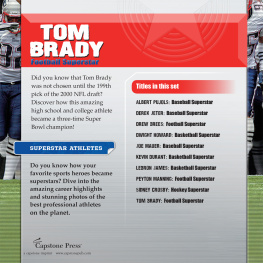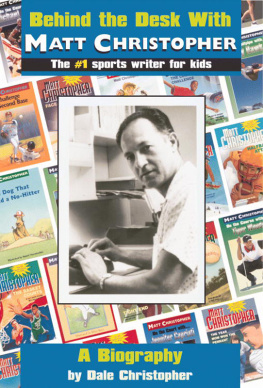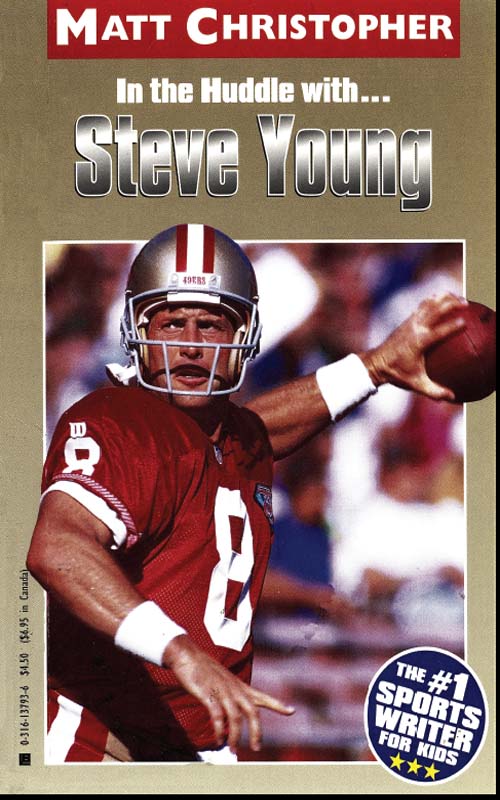Copyright 1996 by Matthew F. Christopher
All rights reserved. No part of this book may be reproduced in any form or by any electronic or mechanical means, including information storage and retrieval systems, without permission in writing from the publisher, except by a reviewer who may quote brief passages in a review.
Hachette Book Group
237 Park Avenue
New York, NY 10017
Visit our website at www.HachetteBookGroup.com
First eBook Edition: December 2009
ISBN: 978-0-316-09434-4
To my son Dale
Chapter One
19611980
San Francisco 49er quarterback Steve Young is one of the best pro football players ever. When Young touches the ball, something exciting usually happens. He might drop straight back and pass the ball deep downfield to an open receiver. Or he might scramble around the pocket, then flip the ball to a running back a split second before being sacked. Or he just might fake a pass, stick the ball under his arm, and run downfield like a running back, dodging some tacklers and barreling over others. Whatever he does, the result is usually the same. The 49ers win!
But if you had to pick one word to describe Steve Young, the person, you probably wouldn't use the word exciting. For while he is certainly one of the most electrifying quarterbacks in the NFL, football is only a part of his life. Off the field he is quiet and mild-mannered. He lives quietly, plays the piano, and gives generously of his time to a number of charities. In the off-season, he went back to college and became a lawyer.
Perhaps the best word to describe Steve Young, person and quarterback, is patient. Young was no overnight sensation. He played football a very, very long time before becoming one of the most exciting players in the history of the National Football League. At every stage of Steve Young's career, from high school and college to professional football, he always started out as a backup to some other player. Yet he never let himself get discouraged. Each time, he remained patient, practiced hard, tried to help his team, and waited for his opportunity to play. When he finally got his chance, he played as well as he could. Over and over, that strategy earned Young the starting quarterback position on each team he played for and allowed him to achieve his goals in life including the biggest goal in football, winning the Super Bowl.
Patience and perseverance are something of a trademark in the Young family. They don't give up easily. Steve's great-great-great-grandfather Brigham Young was a pioneer in the American West. As president of the Church of Jesus Christ of Latter Day Saints, or Mormons, Brigham Young helped lead a group of Mormon settlers from the East and Midwest all the way across North America. They settled in what eventually became the state of Utah.
At first, life was hard for the pioneers. Utah was high desert country. It was hot and very dry in the summer, and cold and snowy in the winter. No one thought the Mormons could survive in such an inhospitable environment. But Brigham Young and his followers didn't give up. They learned to irrigate the land and grow crops in the desert. More and more people moved to Utah. In 1896, nineteen years after Young's death, Utah became the forty-fifth state.
Steve's father, LeGrande Young, was born and raised in Utah. As a young boy, LeGrande earned the nickname Grit, because he was so strong and tough.
Grit Young was also a pretty good football player. He went to Brigham Young University, a college named after his great-great-grandfather, and played running back on the football team. Although the team wasn't very successful, Grit Young was the Cougars' best player.
After he graduated, Grit Young became engaged to and married a classmate, Sherry Steed. He then started studying for a degree in law at the University of Utah.
Grit was still in law school when his first son, Jon Steven Young, was born on October 11, 1961. The young couple called their son plain old Steve. Two years later, they had another son, Michael. Eventually the Youngs had three more children, two boys, named Tom and Jimmy, and a daughter, Melissa.
After Grit graduated from law school in 1964, the Young family moved to Lone Park, a small suburb of Salt Lake City, the Utah state capital. Grit entered the business world and was hired by a large corporation.
In Lone Park, Steve and Michael found plenty of playmates. Whenever they had a chance, they were out in the yard, playing some kind of game.
Even when he was a little boy, Steve was a good athlete. At age two he could do push-ups. At three he learned to dribble a basketball. When he went out to play, Steve usually sought the company of older boys while little Mike trailed behind.
In 1969, Grit Young was transferred by his company to New York City. The entire family piled into their station wagon and headed east, retracing the route that Brigham Young had taken more than one hundred years before. Grit and Sherry Young bought a house in Greenwich, Connecticut, a suburb of New York City.
Steve went into third grade at North Mianus Elementary School. Like many of his classmates, he loved sports. Whenever his teachers would assign a report, Steve would write about sports. After school, he played midget baseball, basketball, and football. He liked football best.
At first Steve played wide receiver, but before too long he was switched to quarterback. Steve was thrilled. His favorite team was the Dallas Cowboys, and their quarterback, Roger Staubach, was his hero. Steve tried to act just like Staubach, although because he was left-handed, he had to do some things differently from the way the right-handed Cowboy did them. With Steve at quarterback, his team won the league championship.
After elementary school, Steve attended Eastern Junior High. He tried out for the football team and was named starting quarterback.
Although Steve was a good player, he wasn't a star. The offense had only a few passing plays, so Steve usually handed off or ran the ball himself.
At the end of one season, Eastern faced arch rival Darien for the league championship. With only seconds left to play, Eastern trailed by a few points but had the ball on the one-yard line. A touchdown would win the game.
The coach sent in a play. Steve was supposed to hand the ball off to the fullback, who would run off-tackle. Eastern lined up at the line of scrimmage, sure they would soon be celebrating a victory. But at the last second, Steve decided he would try to score the touchdown himself.
The center snapped him the ball, and Steve tried to sneak over the goal line. When everyone got untangled, Steve was inches short of the goal. Eastern lost the game.
What happened? the coach yelled at Steve after the game. You were supposed to hand the ball off!
I thought I could make it, answered thirteen-year-old Steve sheepishly. The coach just shook his head. It was hard to stay angry at Steve. He was just trying to win.
There was also more to Steve Young's life than sports. Each Sunday, Steve and his younger brothers and sister rose at five A.M. and traveled thirty miles to attend day-long Mormon religion classes. Each weekday, they awoke at the same time to attend shorter classes before school. Once Steve got to school, he was a straight-A student, well liked by both his classmates and his teachers. Steve's example left an impression on the other Young children. His brother Mike, who later became a doctor, once told a reporter, I owe a lot of what I am to Steve. He wanted everything to be right, so he did everything right. I was able to see the success he had, and it made me want to do that also.





